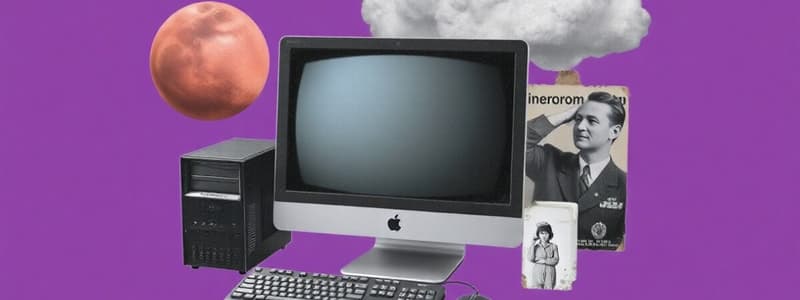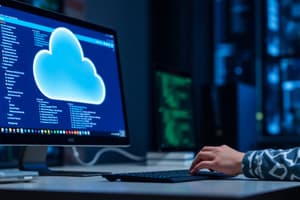Podcast
Questions and Answers
What is End-User Computing (EUC)?
What is End-User Computing (EUC)?
It refers to computer systems and platforms that are meant to allow non-programmers who use computers (the End-Users) to create working applications and outputs.
Which of the following involves the most common hardware aspect of an EUC solution?
Which of the following involves the most common hardware aspect of an EUC solution?
- Desktop and Laptop Computers (correct)
- Desktop Operating Systems and Applications
- Mobile, Web, and Cloud Applications
- Smartphones and Wearables
What does EUD stand for?
What does EUD stand for?
End-User Development
EUC is a process for every organization.
EUC is a process for every organization.
Which of the following is a risk of End-User Computing?
Which of the following is a risk of End-User Computing?
Which is NOT a class of EUC tools?
Which is NOT a class of EUC tools?
Which of the following can an OIS do?
Which of the following can an OIS do?
Give two examples of software packages.
Give two examples of software packages.
Name an example of word processing software.
Name an example of word processing software.
Name an example of electronic spreadsheet software.
Name an example of electronic spreadsheet software.
Name an example of database management software.
Name an example of database management software.
Name an example of graphics design software.
Name an example of graphics design software.
Flashcards
End-User Computing (EUC)
End-User Computing (EUC)
Computer systems that allow non-programmers to create applications.
End-User Development (EUD)
End-User Development (EUD)
The practice where end-users develop their own information systems, supported by IT.
Enhanced Productivity
Enhanced Productivity
Improved efficiency via process streamlining and automation by end-users.
Empowerment of end-users
Empowerment of end-users
Signup and view all the flashcards
Reduction of Unnecessary Steps
Reduction of Unnecessary Steps
Signup and view all the flashcards
Overcoming DP Shortage
Overcoming DP Shortage
Signup and view all the flashcards
User-Friendly Systems
User-Friendly Systems
Signup and view all the flashcards
Errors in Analysis
Errors in Analysis
Signup and view all the flashcards
Lack of Documentation
Lack of Documentation
Signup and view all the flashcards
Faulty Model Risks
Faulty Model Risks
Signup and view all the flashcards
Security/Piracy Issues
Security/Piracy Issues
Signup and view all the flashcards
Application Packages
Application Packages
Signup and view all the flashcards
Fourth-Gen Languages
Fourth-Gen Languages
Signup and view all the flashcards
Office Automation
Office Automation
Signup and view all the flashcards
Office Information System (OIS)
Office Information System (OIS)
Signup and view all the flashcards
Functions
Functions
Signup and view all the flashcards
Software Packages
Software Packages
Signup and view all the flashcards
Process Software
Process Software
Signup and view all the flashcards
Word Processing
Word Processing
Signup and view all the flashcards
Electronic Spreadsheet
Electronic Spreadsheet
Signup and view all the flashcards
Study Notes
End-User Computing (EUC) Defined
- EUC involves computer systems and platforms designed for non-programmers (End-Users).
- It enables users to create working applications and outputs.
- EUC integrates people without programming backgrounds into computing systems development, allowing them to control their computing environment.
- It encompasses all uses of computers by end-users for tasks other than development.
Types of EUC
- Desktop and Laptop Computers: Common hardware solutions customizable for specific user needs.
- Desktop Operating Systems and Applications: Software aspects that may come packaged or sold separately, like Windows System and Administrator Tools.
- Smartphones and Wearables: Mobile hardware platforms (smartphones, tablets, smartwatches) with related apps and widgets.
- Mobile, Web, and Cloud Applications: Prioritize mobility and connectivity as services, like e-mail, instant messaging, and cloud storage.
- Virtual Desktops and Applications: Cloud-based computing that eliminates hardware needs, promoting the "Bring Your Own Device" (BYOD) trend, such as Microsoft Office 365.
End-User Development (EUD) Defined
- EUD is an EUC practice where end-users develop their information systems, supported by IT professionals.
- End-users gain access to facilities, resources, and training.
Benefits of End-User Computing
- Enhanced productivity via streamlined processes and automation.
- Empowerment of end-users to create their system solutions.
- Reduction/Elimination of unnecessary steps in business processes through end-user involvement.
- Overcoming shortages of DP professionals via software training for end-users.
- User-friendly and responsive systems due to direct end-user involvement.
Risks of End-User Computing
- Errors in analysis due to poorly trained end-users.
- Lack of documentation due to a lack of formal training.
- Faulty Models where Decision Support Systems (DSS) rely on corporate models developed by end-users, recent research indicates that as many as 38% of these spreadsheets may contain errors.
- Possible Security/Piracy Issues, organization data may be at risk of being manipulated and/or stolen.
End-User Computing Tools
- Application Packages: Pre-written, customizable software for business functions like payroll, ledgers, scheduling and inventory, for example Microsoft Office Suite.
- Fourth-Generation Programming Languages: Languages allowing end-users to develop and consolidate computing solutions, like SQL for managing databases.
End-User Systems Tools
- Text and Multimedia Handling Tools: Word processing, desktop publishing, presentation software, document management.
- Data Handling Tools: Spreadsheets, statistical packages, decision support systems, databases.
- Communication Tools: E-mail, VoIP, fax, WAP, pagers.
- Office Automation Tools: Diary management, electronic notebooks, directories, project management tools.
- Group Systems / Computer Supported Collaborative Work: Teleconferencing, virtual workspaces/desktops.
- Graphic Design: Graphic software, computer-aided design.
- Knowledge Management: Expert systems, data mining, information retrieval.
Office Automation (OA) Defined
- It is the complete integration of basic office requirements for a department.
- Requirements include word processing, electronic data filing, diary management, and communications.
- Aims to organize functions without needing separate actions or additional resources.
Office Information System (OIS) Defined
- This is a system that uses software, hardware, and networking.
- Goal is to improve workflow and communication.
- It supports business activities to allow management and workforce efficiency.
- Systems can evolve and become automated, increasing flexibility and effectiveness.
Capabilities of an OIS
- Facilitates electronic communication through e-mail and messaging.
- Manages audio-video communication via telephony, teleconferencing, or prompt directories.
- Record management through databases and data servers.
- Automates business processes to reduce manpower.
- Provides EUC to enhance employee efficiency further.
Applications of Office Automation
- Functions: Actions performed via function keys (Cut, Copy, Delete, etc.).
- Software Packages: Bundled applications for tasks like document creation (Microsoft Office, Google Docs).
- Process Software: Individual or bundled software for specific capabilities (Autodesk's AutoCAD).
- Word Processing: Software for textual documents (Notepad, Microsoft Word).
- Electronic Spreadsheet: Software for accounting and financial tasks (Microsoft Excel).
- Database Management: Organized electronic storage (Microsoft Access, MySQL).
- Desktop Publishing: Laying out text, graphics and pictures onto a page.
- Graphics Design: Creating charts/graphs (Microsoft PowerPoint, Adobe Photoshop).
- Project Management: Identifying tasks and resources.
- Calendar: Scheduling events.
- Electronic Communication: Sending information via networks (Microsoft Outlook).
Studying That Suits You
Use AI to generate personalized quizzes and flashcards to suit your learning preferences.



